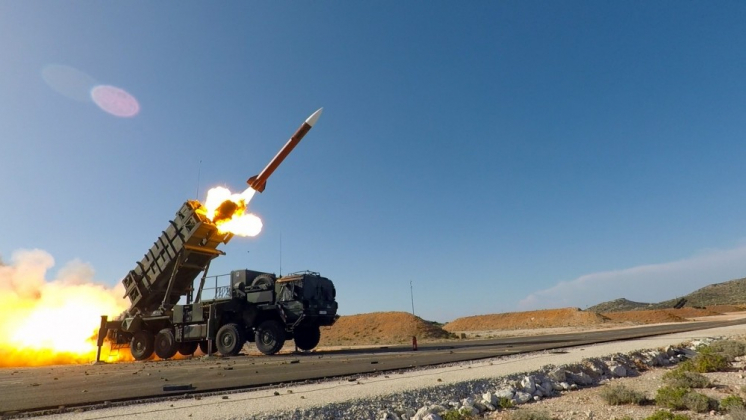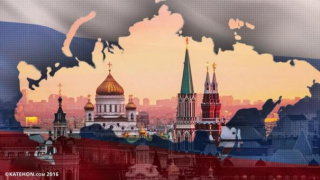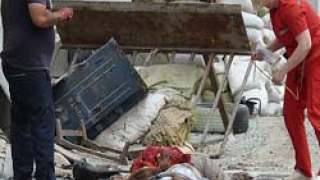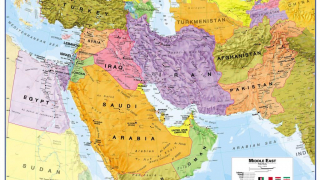Is The US Preparing For War With Russia?
The RAND Corporation recently published a document entitled Overextending and Unbalancing Russia. Assessing the Impact of Cost-Imposing Options. The study is the collective effort of experienced diplomats, including former Assistant Secretary of State for Europe and US Ambassador to the European Union James Dobbins; a professor (Brookings Institution, American Enterprise Institute, National Defence University) and military intelligence branched lieutenant colonel in the Army Reserve, Raphael Cohen; and seven other RAND researchers who specialise in international relations, the military industry, intelligence, politics, and technology.
It is a practical recommendation for how the US can use Russia’s weakness and vulnerability to further limit its political and economic potential.
It is also a kind of summary of a much more extensive monograph of some 300-odd pages entitled Extending Russia. Competing from Advantageous Ground by the same authors.
So what, exactly, are these influential political analysts suggesting to the American establishment?
Their full spectrum of operations is divided into four sections – economic, geopolitical, ideological and informational, and military measures. It is clear that the experts approached the development of their strategy rationally by measuring the potential costs for the US itself.
The economic section consists of four options that Russia has already been directly affected by in previous years. The first of these is expanding the production and export of US energy resources, which would affect global prices and therefore limit Russia’s profits. The second is strengthening sanctions, where the involvement of other countries in such a process is seen as essential. Next is helping Europe find new gas suppliers, including for LNG supplies. And, finally, encouraging migration from Russia to other countries, especially with regard to skilled workers and educated young people. It is assumed that the first three options would be the most beneficial to the US, although imposing deeper sanctions could bring certain risks.
In the section on geopolitical measures, the US experts propose six geopolitical scenarios aimed at weakening Russia. They don’t just involve the Russian Federation, either, but neighbouring countries as well. Each scenario has certain risks, costs, and an expected impact.
According to the Americans, helping Ukraine by supplying the country with weapons would exploit Russia’s greatest vulnerability. But any increase in the supply of US weapons and advice to Ukraine would need to be carefully calibrated in order to increase the costs to Russia of supporting its existing commitments without provoking a much wider conflict in which Russia, by reason of proximity, would have significant advantages.
Syrian Democratic Forces trainees, representing an equal number of Arab and Kurdish volunteers, stand in formation at their graduation ceremony in northern Syria, August 9, 2017.
This is the first option. The RAND experts believe that this will be the most beneficial, but that its possible realisation will also involve high risks.
The second option is to increase support to the Syrian rebels. This could jeopardise other US policy priorities, however, such as combating radical Islamic terrorism, and could destabilise the entire region even further. It might not even be possible, given the radicalisation, fragmentation, and decline of the Syrian opposition.
The RAND experts obviously understand all the possible dangers involved in this scenario, but, reading between the lines, it is easy to see that this option is basically implying the use of terrorist groups in the geopolitical interests of the US. There is nothing new about this method in and of itself, but it can be rather costly to implement and comes with considerable risks, and, in the best case scenario, the likelihood of success is moderate. It could also upset America’s traditional allies, as happened during the Iraq invasion to overthrow Saddam Hussein.
The third option is promoting liberalisation in Belarus. The authors admit that this is unlikely to succeed, however, and could provoke a strong response from Russia, which would lead to a general worsening of the security situation in Europe and be a setback for US policy. As with the first option, it comes with high risk, but the benefits could also be considerable. Needless to say that what is really being referred to here is a colour revolution in the Republic of Belarus. The country’s leadership should pay attention to this recommendation by the RAND Corporation and ask the US diplomats in Minsk for comment.
Expanding ties in the South Caucasus, which competes economically with Russia, is the fourth option, but it would be difficult to implement because of geography and history.
The fifth scenario is reducing Russia’s influence in Central Asia, which could also prove difficult and disproportionately expensive for the US.
And the sixth, and final, scenario is organising an uprising in Transnistria and expelling Russian troops, which would be a blow to Russia’s prestige. This could also have the opposite effect, however, since Moscow would save money, but it could well lead to additional costs for the US and its allies.
Muscovites protesting the war in Ukraine and Russia’s support of separatism in the Crimea on the Circular Boulevards in Moscow on March 15, 2014
It should be noted that all six scenarios are aimed at Russia’s neighbours. They are a kind of re-working of the old Anaconda strategy unleashed on Russia’s borders.
The section on ideological and informational measures is aimed at the Russian Federation’s domestic policies and is essentially interfering in the country’s affairs. There are just four scenarios, but they speak for themselves: undermining faith in the electoral system; creating the idea that the political elite does not serve the interests of society; instigating protests and non-violent resistance; and undermining Russia’s image abroad.
Tellingly, the proposed military measures against Russia have the largest number of options and are separated into three strategic areas – air, sea, and land.
It states that repositioning bombers to within striking distance of key Russian strategic targets would have a high likelihood of success and would undoubtedly attract Moscow’s attention and cause unease. The costs and risks associated with this option would be fairly low, as long as the bombers are based out of range of most of Russia’s ballistic and ground-based cruise missiles.
Marines assigned to the Thunderbolts of Marine Fighter Attack Squadron (VMFA) 251 remove a training AGM-88 HARM from an F/A-18C Hornet on the flight deck of the Nimitz-class aircraft carrier USS Theodore Roosevelt (CVN 71).
Reposturing fighter jets so that they are closer to their targets than bombers. Although the RAND experts believe that such actions could worry Moscow more than the option with the bombers, the probability of success is low but the risks are high. Since each aircraft would have to fly several sorties during a conventional conflict because of low payload, there is a risk that they could be destroyed on the ground and their deployment airfields could be shut down early on.
Deploying additional tactical nuclear weapons to parts of Europe and Asia could increase Russia’s worry, which could lead to a significant increase in investment in its air defences. In combination with the ‘bomber’ option, it has a high probability of success, but deploying a large number of these weapons could make Moscow react in ways that go against the interests of the US and its allies.
Repositioning US and allied ballistic missile defence systems to better deter Russian ballistic missiles would also make Moscow uneasy, but it would probably be the least effective option since Russia has plenty of missiles that could be used for any upgrades. US and allied targets would also remain at risk.
A U.S. sailor aboard the guided missile destroyer USS Mustin (DDG 89) fires a torpedo at a simulated target during Valiant Shield 2014 in the Pacific Ocean September 18, 2014.
The report also suggests developing new low-observable, long-range bombers or significantly increasing the number of those types that are already causing unease in Moscow. There is also mention of high numbers of autonomous or remotely piloted strike aircraft.
As the RAND experts point out, the key risk of these options is an arms race, which could lead to cost-imposing strategies directed against the United States. For example, investing in ballistic missile defence systems and space-based weapons would alarm Moscow, but Russia could defend itself against such developments by taking measures that would probably be considerably cheaper than the cost of these systems to the United States.
With regard to a maritime confrontation, RAND suggests increasing the presence of US and allied navies in those zones considered potentially dangerous because of Russia. It is probably safe to assume that this is referring to the Baltic Sea, the Arctic, and the Black Sea/Mediterranean Basin. The report also mentions increasing investment in research and developing new types of weapons that could strike Russian nuclear submarines. At the same time, it would be a good idea for the US itself to increase the fleet of submarines in its nuclear triad. And, finally, with regard to the Black Sea, the report suggests using NATO to develop an access denial strategy – probably through the deployment of long-range, anti-ship missiles – in order to increase Russia’s defence spending in Crimea.
On land, the report’s authors believe that there should be an increase in the number of European NATO troops deployed directly on the Russian border. They also emphasise the importance of increasing the size and scale of NATO exercises in Europe, which would send a clear signal to Russia. Another option is to develop intermediate-range missiles but not deploy them, which would force Russia to upgrade its missile programme (an additional cost). And, finally, the report suggests investing in new technologies (weapons based on new physical principles such as lasers) aimed at countering Russian air defence systems.
Exercise Artemis Strike was a German-led tactical live-fire exercise with live Patriot and Stinger missiles at the NATO Missile Firing Installation in Chania, Greece, from October 31 to November 9, 2017
As can be seen, all four sections are complementary in their diversity. The Pentagon has already been working on some innovations in the last few years as part of the Third Offset Strategy, while the current and new budget suggests that, one way or another, the US will continue to build up its military power.
Together with other advisory documents for high-level decision makers in the US, this report by RAND experts is evidence of a large-scale campaign being carried out against Russia. It is surprising, however, that all of the recommendations, especially those included in the military section, are virtually pointing to the preparation of a war with Russia. It calmly talks about what the US can do about existing arms limitation treaties, how to use NATO, and how to use Ukraine in the war with Russia, especially on land and in the Black Sea theatre of operations. There is no doubt that the recommendations themselves were passed on to US decision-making centres a long time before April 2019, when the monograph was published. All that remains is to monitor the implementation of these scenarios and take the appropriate countermeasures.



















